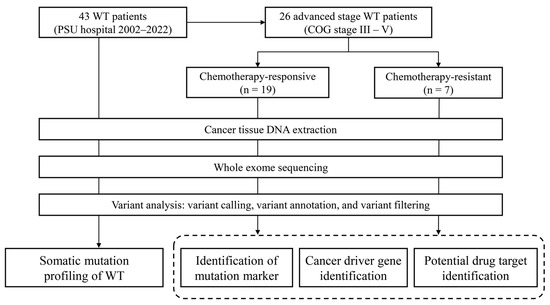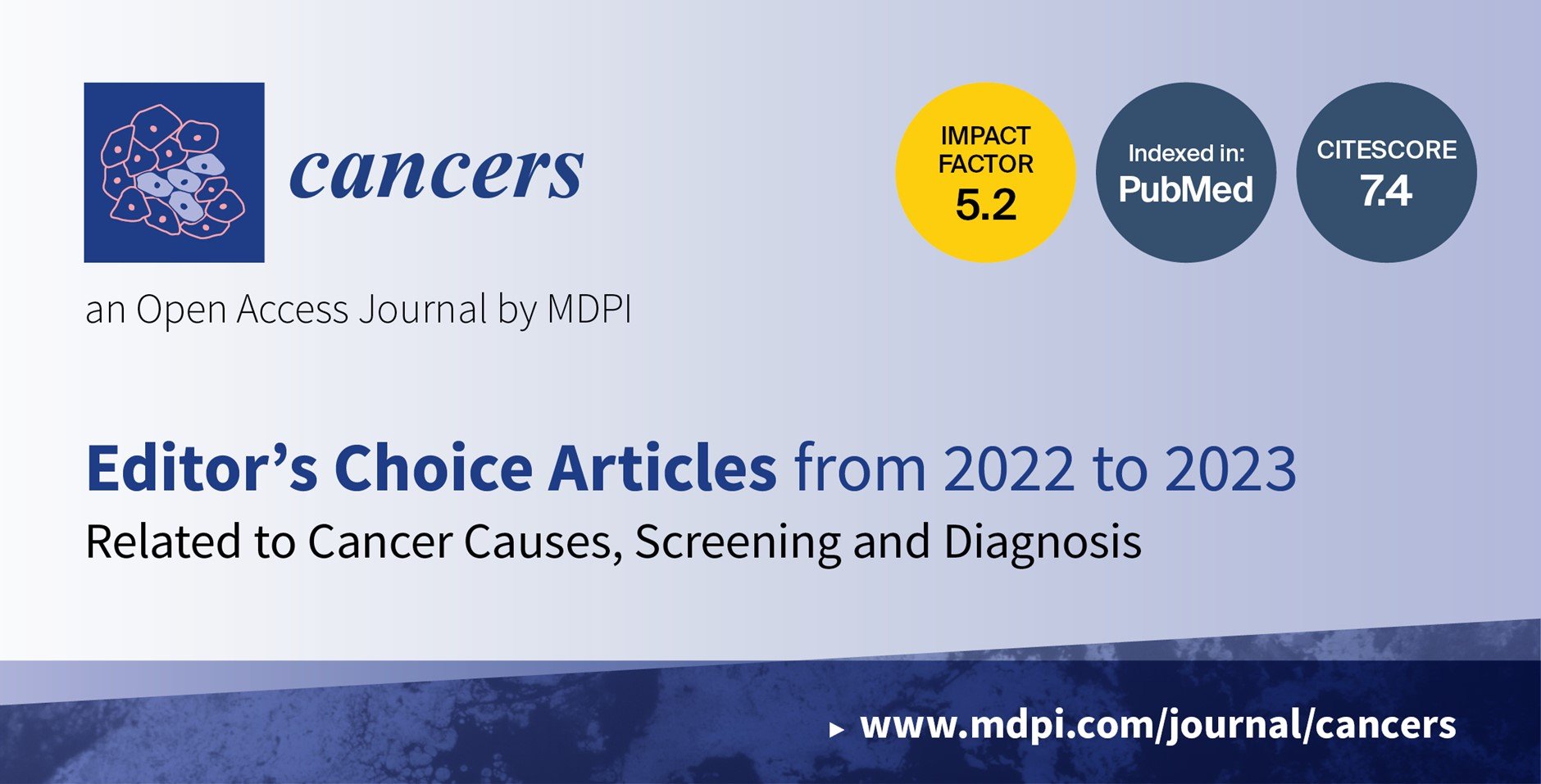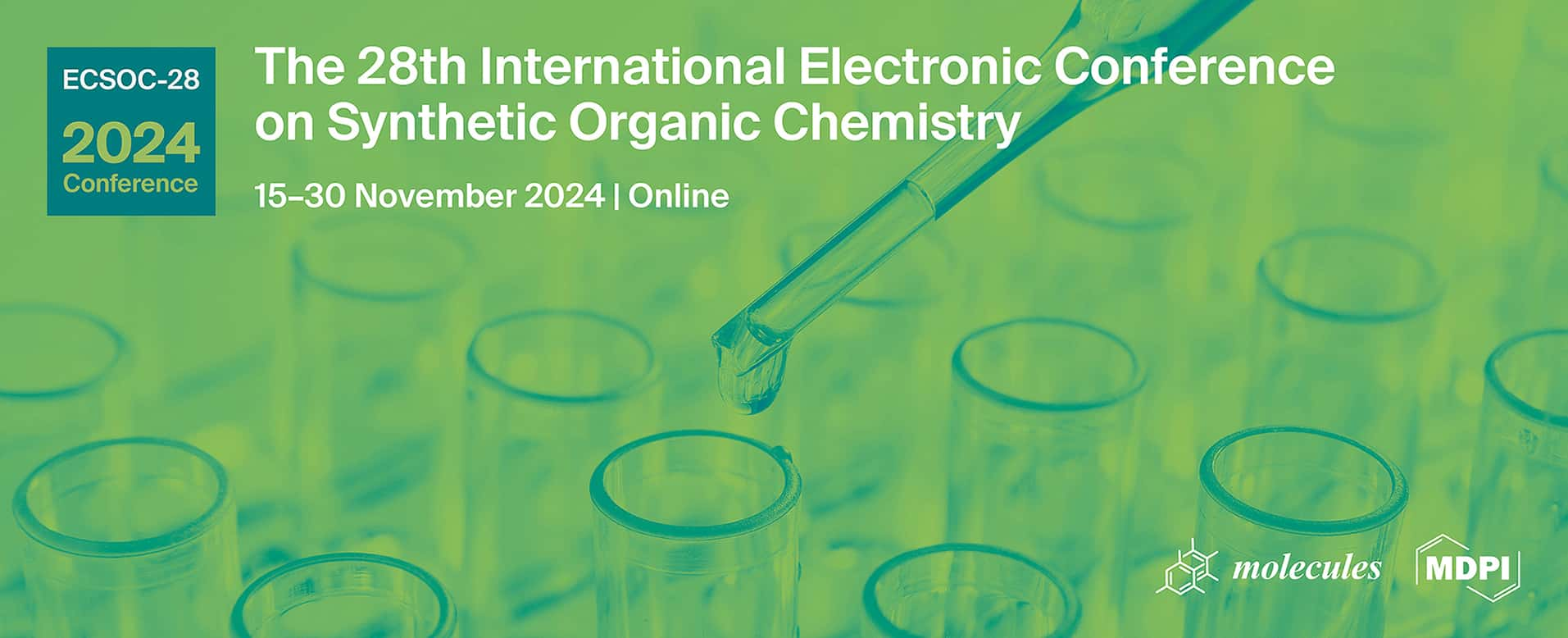-
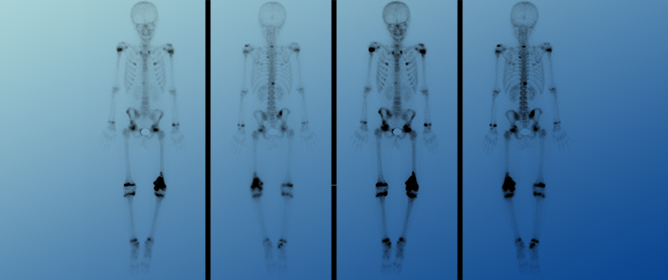 Primary Multi-Systemic Metastases in Osteosarcoma: Presentation, Treatment, and Survival of 83 Patients of the Cooperative Osteosarcoma Study Group
Primary Multi-Systemic Metastases in Osteosarcoma: Presentation, Treatment, and Survival of 83 Patients of the Cooperative Osteosarcoma Study Group -
 Addressing Genetic Tumor Heterogeneity, Post-Therapy Metastatic Spread, Cancer Repopulation, and Development of Acquired Tumor Cell Resistance
Addressing Genetic Tumor Heterogeneity, Post-Therapy Metastatic Spread, Cancer Repopulation, and Development of Acquired Tumor Cell Resistance -
 The Role of Macrophages in Sarcoma Tumor Microenvironment and Treatment
The Role of Macrophages in Sarcoma Tumor Microenvironment and Treatment -
 Synergistic Sensitization of High-Grade Serous Ovarian Cancer Cells Lacking Caspase-8 Expression to Chemotherapeutics Using Combinations of Small-Molecule BRD4 and CDK9 Inhibitors
Synergistic Sensitization of High-Grade Serous Ovarian Cancer Cells Lacking Caspase-8 Expression to Chemotherapeutics Using Combinations of Small-Molecule BRD4 and CDK9 Inhibitors
Journal Description
Cancers
Cancers
is a peer-reviewed, open access journal of oncology, published semimonthly online by MDPI. The Irish Association for Cancer Research (IACR), Spanish Association for Cancer Research (ASEICA), Biomedical Research Centre (CIBM), British Neuro-Oncology Society (BNOS) and Spanish Group for Cancer Immuno-Biotherapy (GÉTICA) are affiliated with Cancers and their members receive a discount on the article processing charges.
- Open Access— free for readers, with article processing charges (APC) paid by authors or their institutions.
- High Visibility: indexed within Scopus, SCIE (Web of Science), PubMed, PMC, Embase, CAPlus / SciFinder, and other databases.
- Journal Rank: JCR - Q2 (Oncology) / CiteScore - Q1 (Oncology)
- Rapid Publication: manuscripts are peer-reviewed and a first decision is provided to authors approximately 17.9 days after submission; acceptance to publication is undertaken in 2.8 days (median values for papers published in this journal in the second half of 2023).
- Recognition of Reviewers: reviewers who provide timely, thorough peer-review reports receive vouchers entitling them to a discount on the APC of their next publication in any MDPI journal, in appreciation of the work done.
- Sections: published in 18 topical sections.
- Companion journals for Cancers include: Radiation and Onco.
Impact Factor:
5.2 (2022);
5-Year Impact Factor:
5.6 (2022)
Latest Articles
Discovery of Novel Potential Prognostic Markers and Targeted Therapy to Overcome Chemotherapy Resistance in an Advanced-Stage Wilms Tumor
Cancers 2024, 16(8), 1567; https://0-doi-org.brum.beds.ac.uk/10.3390/cancers16081567 (registering DOI) - 19 Apr 2024
Abstract
Wilms tumor (WT), the most prevalent type of renal cancer in children, exhibits overall survival rates exceeding 90%. However, chemotherapy resistance, which occurs in approximately 10% of WT cases, is a major challenge for the treatment of WT, particularly for advanced-stage patients. In
[...] Read more.
Wilms tumor (WT), the most prevalent type of renal cancer in children, exhibits overall survival rates exceeding 90%. However, chemotherapy resistance, which occurs in approximately 10% of WT cases, is a major challenge for the treatment of WT, particularly for advanced-stage patients. In this study, we aimed to discover potential mutation markers and drug targets associated with chemotherapy resistance in advanced-stage WT. We performed exome sequencing to detect somatic mutations and molecular targets in 43 WT samples, comprising 26 advanced-stage WTs, of which 7 cases were chemotherapy-resistant. Our analysis revealed four genes (ALPK2, C16orf96, PRKDC, and SVIL) that correlated with chemotherapy resistance and reduced disease-free survival in advanced-stage WT. Additionally, we identified driver mutations in 55 genes within the chemotherapy-resistant group, including 14 druggable cancer driver genes. Based on the mutation profiles of the resistant WT samples, we propose potential therapeutic strategies involving platinum-based agents, PARP inhibitors, and antibiotic/antineoplastic agents. Our findings provide insights into the genetic landscape of WT and offer potential avenues for targeted treatment, particularly for patients with chemotherapy resistance.
Full article
(This article belongs to the Section Cancer Biomarkers)
►
Show Figures
Open AccessReview
Advancements in Image-Based Models for High-Grade Gliomas Might Be Accelerated
by
Guido Frosina
Cancers 2024, 16(8), 1566; https://0-doi-org.brum.beds.ac.uk/10.3390/cancers16081566 (registering DOI) - 19 Apr 2024
Abstract
The first half of 2022 saw the publication of several major research advances in image-based models and artificial intelligence applications to optimize treatment strategies for high-grade gliomas, the deadliest brain tumors. We review them and discuss the barriers that delay their entry into
[...] Read more.
The first half of 2022 saw the publication of several major research advances in image-based models and artificial intelligence applications to optimize treatment strategies for high-grade gliomas, the deadliest brain tumors. We review them and discuss the barriers that delay their entry into clinical practice; particularly, the small sample size and the heterogeneity of the study designs and methodologies used. We will also write about the poor and late palliation that patients suffering from high-grade glioma can count on at the end of life, as well as the current legislative instruments, with particular reference to Italy. We suggest measures to accelerate the gradual progress in image-based models and end of life care for patients with high-grade glioma.
Full article
(This article belongs to the Special Issue Radiobiological Modelling in the New Era of Precision Radiation Oncology)
Open AccessArticle
Enhancements in Radiological Detection of Metastatic Lymph Nodes Utilizing AI-Assisted Ultrasound Imaging Data and the Lymph Node Reporting and Data System Scale
by
Cezary Chudobiński, Bartosz Świderski, Izabella Antoniuk and Jarosław Kurek
Cancers 2024, 16(8), 1564; https://0-doi-org.brum.beds.ac.uk/10.3390/cancers16081564 (registering DOI) - 19 Apr 2024
Abstract
The paper presents a novel approach for the automatic detection of neoplastic lesions in lymph nodes (LNs). It leverages the latest advances in machine learning (ML) with the LN Reporting and Data System (LN-RADS) scale. By integrating diverse datasets and network structures, the
[...] Read more.
The paper presents a novel approach for the automatic detection of neoplastic lesions in lymph nodes (LNs). It leverages the latest advances in machine learning (ML) with the LN Reporting and Data System (LN-RADS) scale. By integrating diverse datasets and network structures, the research investigates the effectiveness of ML algorithms in improving diagnostic accuracy and automation potential. Both Multinominal Logistic Regression (MLR)-integrated and fully connected neuron layers are included in the analysis. The methods were trained using three variants of combinations of histopathological data and LN-RADS scale labels to assess their utility. The findings demonstrate that the LN-RADS scale improves prediction accuracy. MLR integration is shown to achieve higher accuracy, while the fully connected neuron approach excels in AUC performance. All of the above suggests a possibility for significant improvement in the early detection and prognosis of cancer using AI techniques. The study underlines the importance of further exploration into combined datasets and network architectures, which could potentially lead to even greater improvements in the diagnostic process.
Full article
(This article belongs to the Section Cancer Metastasis)
Open AccessReview
Latest Insights and Therapeutic Advances in Myelodysplastic Neoplasms
by
Pasquale Niscola, Valentina Gianfelici, Marco Giovannini, Daniela Piccioni, Carla Mazzone and Paolo de Fabritiis
Cancers 2024, 16(8), 1563; https://0-doi-org.brum.beds.ac.uk/10.3390/cancers16081563 (registering DOI) - 19 Apr 2024
Abstract
Myelodysplastic syndromes/neoplasms (MDSs) encompass a range of hematopoietic malignancies, commonly affecting elderly individuals. Molecular alterations in the hematopoietic stem cell compartment drive disease pathogenesis. Recent advancements in genomic profiling have provided valuable insights into the biological underpinnings of MDSs and have expanded therapeutic
[...] Read more.
Myelodysplastic syndromes/neoplasms (MDSs) encompass a range of hematopoietic malignancies, commonly affecting elderly individuals. Molecular alterations in the hematopoietic stem cell compartment drive disease pathogenesis. Recent advancements in genomic profiling have provided valuable insights into the biological underpinnings of MDSs and have expanded therapeutic options, particularly for specific molecularly defined subgroups. This review highlights the diagnostic principles, classification updates, prognostic stratification systems, and novel treatments, which could inform future clinical trials and enhance the management of adult MDS patients, particularly for specific molecularly defined subgroups.
Full article
(This article belongs to the Section Cancer Therapy)
►▼
Show Figures
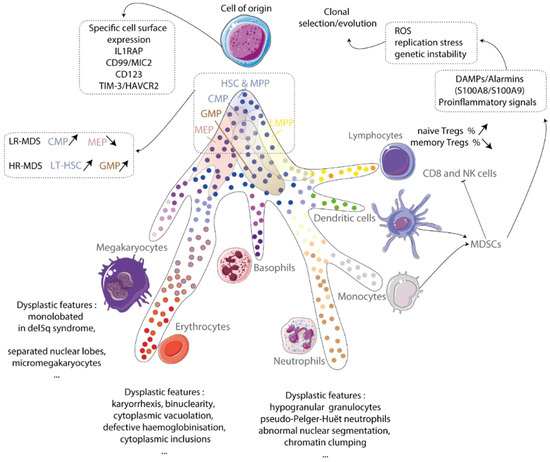
Figure 1
Open AccessArticle
Safety and Outcomes of Inferior Vena Cava Filter Placement in Oncology Patients: A Single-Centre Experience
by
Paweł Kurzyna, Marta Banaszkiewicz, Michał Florczyk, Jarosław Kępski, Michał Piłka, Piotr Kędzierski, Rafał Mańczak, Piotr Szwed, Krzysztof Kasperowicz, Katarzyna Wrona, Grzegorz Doroszewski, Adam Torbicki, Marcin Kurzyna, Sebastian Szmit and Szymon Darocha
Cancers 2024, 16(8), 1562; https://0-doi-org.brum.beds.ac.uk/10.3390/cancers16081562 - 19 Apr 2024
Abstract
The risk of venous thromboembolism (VTE) in the oncology population is significantly higher than in non-cancer patients. Inferior vena cava (IVC) filters may, therefore, be an important part of VTE treatment. In this study, we address the outcomes of placing IVC filters in
[...] Read more.
The risk of venous thromboembolism (VTE) in the oncology population is significantly higher than in non-cancer patients. Inferior vena cava (IVC) filters may, therefore, be an important part of VTE treatment. In this study, we address the outcomes of placing IVC filters in the oncology population. This single-centre, observational, retrospective study included 62 patients with active malignancy and acute VTE who underwent an IVC filter implantation due to contraindications to anticoagulation during the period 2012–2023. The control group consisted of 117 trauma patients. In both groups, an urgent surgical procedure requiring temporary cessation of anticoagulation was the most noted reason for IVC filter placement—76% in the oncology group vs. 100% in the non-oncology group (p < 0.001). No complications were reported during the IVC filter implantation procedures. There was no recurrence of pulmonary embolism or deep venous thrombosis in the oncology group after filter implantation. The rate of successful filter explantation, median time to retrieval, and abnormal findings during retrieval were not significantly different between both subgroups (64.3% vs. 76.5%, p = 0.334; 77 days vs. 84 days, p = 0.764; 61.5% vs. 54.2%, p = 0.672; respectively). The study showed that IVC filter placement is a safe and effective method of preventing PE in cancer patients with contraindications to anticoagulation. The complication rate following IVC filter implantation in cancer patients is low and similar to that in non-oncology patients.
Full article
(This article belongs to the Section Cancer Survivorship and Quality of Life)
►▼
Show Figures
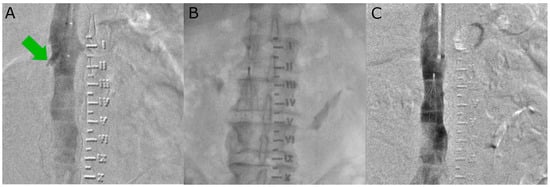
Figure 1
Open AccessArticle
NGS-Guided Precision Oncology in Breast Cancer and Gynecological Tumors—A Retrospective Molecular Tumor Board Analysis
by
Niklas Gremke, Fiona R. Rodepeter, Julia Teply-Szymanski, Sebastian Griewing, Jelena Boekhoff, Alina Stroh, Thomas S. Tarawneh, Jorge Riera-Knorrenschild, Christina Balser, Akira Hattesohl, Martin Middeke, Petra Ross, Anne-Sophie Litmeyer, Marcel Romey, Thorsten Stiewe, Thomas Wündisch, Andreas Neubauer, Carsten Denkert, Uwe Wagner and Elisabeth K. M. Mack
Cancers 2024, 16(8), 1561; https://0-doi-org.brum.beds.ac.uk/10.3390/cancers16081561 - 19 Apr 2024
Abstract
Background: Precision oncology treatments are being applied more commonly in breast and gynecological oncology through the implementation of Molecular Tumor Boards (MTBs), but real-world clinical outcome data remain limited. Methods: A retrospective analysis was conducted in patients with breast cancer (BC) and gynecological
[...] Read more.
Background: Precision oncology treatments are being applied more commonly in breast and gynecological oncology through the implementation of Molecular Tumor Boards (MTBs), but real-world clinical outcome data remain limited. Methods: A retrospective analysis was conducted in patients with breast cancer (BC) and gynecological malignancies referred to our center’s MTB from 2018 to 2023. The analysis covered patient characteristics, next-generation sequencing (NGS) results, MTB recommendations, therapy received, and clinical outcomes. Results: Sixty-three patients (77.8%) had metastatic disease, and forty-four patients (54.3%) had previously undergone three or more lines of systemic treatment. Personalized treatment recommendations were provided to 50 patients (63.3%), while 29 (36.7%) had no actionable target. Ultimately, 23 patients (29.1%) underwent molecular-matched treatment (MMT). Commonly altered genes in patients with pan-gyn tumors (BC and gynecological malignancies) included TP53 (n = 42/81, 51.9%), PIK3CA (n = 18/81, 22.2%), BRCA1/2 (n = 10/81, 12.3%), and ARID1A (n = 9/81, 11.1%). Patients treated with MMT showed significantly prolonged progression-free survival (median PFS 5.5 vs. 3.5 months, p = 0.0014). Of all patients who underwent molecular profiling, 13.6% experienced a major clinical benefit (PFSr ≥ 1.3 and PR/SD ≥ 6 months) through precision oncology. Conclusions: NGS-guided precision oncology demonstrated improved clinical outcomes in a subgroup of patients with gynecological and breast cancers.
Full article
(This article belongs to the Special Issue Genetics and Epigenetics of Gynecological Cancer)
►▼
Show Figures
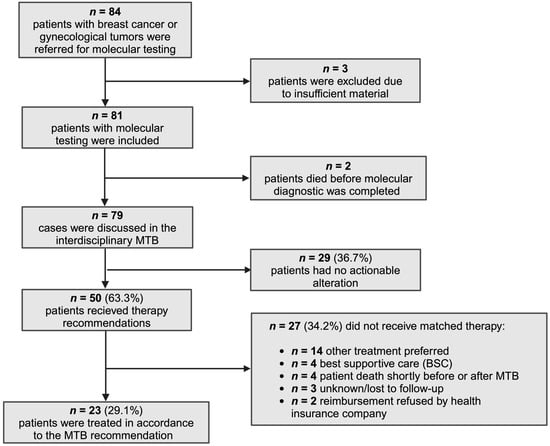
Figure 1
Open AccessReview
A Perspective Review: Analyzing Collagen Alterations in Ovarian Cancer by High-Resolution Optical Microscopy
by
Kristal L. Gant, Manish S. Patankar and Paul J. Campagnola
Cancers 2024, 16(8), 1560; https://0-doi-org.brum.beds.ac.uk/10.3390/cancers16081560 - 19 Apr 2024
Abstract
High-grade serous ovarian cancer (HGSOC) is the predominant subtype of ovarian cancer (OC), occurring in more than 80% of patients diagnosed with this malignancy. Histological and genetic analysis have confirmed the secretory epithelial of the fallopian tube (FT) as a major site of
[...] Read more.
High-grade serous ovarian cancer (HGSOC) is the predominant subtype of ovarian cancer (OC), occurring in more than 80% of patients diagnosed with this malignancy. Histological and genetic analysis have confirmed the secretory epithelial of the fallopian tube (FT) as a major site of origin of HGSOC. Although there have been significant strides in our understanding of this disease, early stage detection and diagnosis are still rare. Current clinical imaging modalities lack the ability to detect early stage pathogenesis in the fallopian tubes and the ovaries. However, there are several microscopic imaging techniques used to analyze the structural modifications in the extracellular matrix (ECM) protein collagen in ex vivo FT and ovarian tissues that potentially can be modified to fit the clinical setting. In this perspective, we evaluate and compare the myriad of optical tools available to visualize these alterations and the invaluable insights these data provide on HGSOC initiation. We also discuss the clinical implications of these findings and how these data may help novel tools for early diagnosis of HGSOC.
Full article
(This article belongs to the Special Issue Advances in Oncological Imaging)
►▼
Show Figures
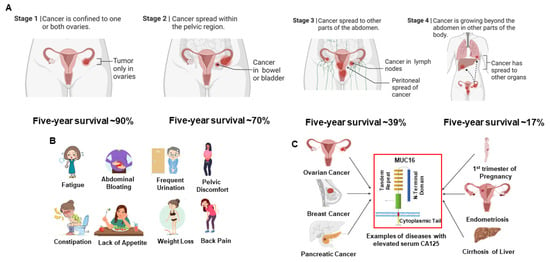
Figure 1
Open AccessArticle
Pressurised Intraperitoneal Aerosolised Chemotherapy—Results from the First Hundred Consecutive Procedures
by
David Hoskovec, Zdeněk Krška, Michal Vočka, Soňa Argalácsová and Petr Dytrych
Cancers 2024, 16(8), 1559; https://0-doi-org.brum.beds.ac.uk/10.3390/cancers16081559 - 19 Apr 2024
Abstract
PIPAC is a new and promising technique for the intraperitoneal administration of chemotherapy. It can be used in patients with various peritoneal cancer metastases. It is mainly a palliative treatment, but there is some neoadjuvant treatment potential. We have operated on 41 patients
[...] Read more.
PIPAC is a new and promising technique for the intraperitoneal administration of chemotherapy. It can be used in patients with various peritoneal cancer metastases. It is mainly a palliative treatment, but there is some neoadjuvant treatment potential. We have operated on 41 patients with various intra-abdominal cancers. PIPAC was performed every 6 weeks. The indication was extension of peritoneal carcinomatosis beyond the criteria for cytoreductive surgery and HIPEC. The effect was evaluated according to the peritoneal cancer index, the peritoneal regression grading score and the amount of ascites. Complications were classified according to the Clavien-Dindo system. We have performed 100 PIPAC procedures. There were two major complications, classified as Clavien Dindo III (2%). The number of procedures varied from 1 to 6. Five patients switched to cytoreductive surgery and HIPEC, and one was indicated for the watch and wait strategy due to total regression according to PRGS. Three patients are still continuing treatment. The others stopped treatment mainly because of progression of the disease and loss of metastases. We observed a reduction in ascites production soon after PIPAC application. PIPAC is a safe and well-tolerated treatment modality. It is mainly a palliative treatment that can improve the quality of life by reducing the production of ascites, but in about 10% of cases, it can reduce the extent of the disease and allow for further radical treatment.
Full article
(This article belongs to the Section Cancer Therapy)
►▼
Show Figures
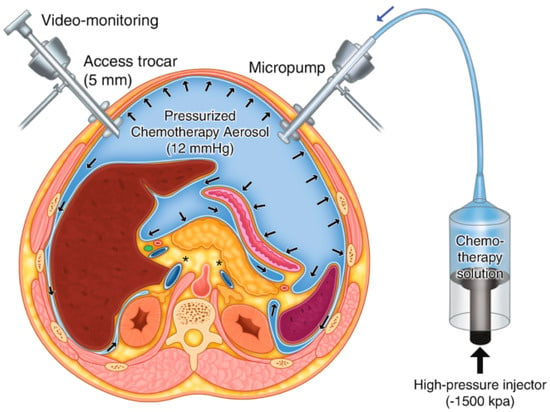
Figure 1
Open AccessReview
Therapeutic Strategies for RB1-Deficient Cancers: Intersecting Gene Regulation and Targeted Therapy
by
Mo-Fan Huang, Yuan-Xin Wang, Yu-Ting Chou and Dung-Fang Lee
Cancers 2024, 16(8), 1558; https://0-doi-org.brum.beds.ac.uk/10.3390/cancers16081558 - 19 Apr 2024
Abstract
The retinoblastoma (RB) transcriptional corepressor 1 (RB1) is a critical tumor suppressor gene, governing diverse cellular processes implicated in cancer biology. Dysregulation or deletion in RB1 contributes to the development and progression of various cancers, making it a prime target for therapeutic intervention.
[...] Read more.
The retinoblastoma (RB) transcriptional corepressor 1 (RB1) is a critical tumor suppressor gene, governing diverse cellular processes implicated in cancer biology. Dysregulation or deletion in RB1 contributes to the development and progression of various cancers, making it a prime target for therapeutic intervention. RB1′s canonical function in cell cycle control and DNA repair mechanisms underscores its significance in restraining aberrant cell growth and maintaining genomic stability. Understanding the complex interplay between RB1 and cellular pathways is beneficial to fully elucidate its tumor-suppressive role across different cancer types and for therapeutic development. As a result, investigating vulnerabilities arising from RB1 deletion-associated mechanisms offers promising avenues for targeted therapy. Recently, several findings highlighted multiple methods as a promising strategy for combating tumor growth driven by RB1 loss, offering potential clinical benefits in various cancer types. This review summarizes the multifaceted role of RB1 in cancer biology and its implications for targeted therapy.
Full article
(This article belongs to the Special Issue Genes in Cancer)
►▼
Show Figures
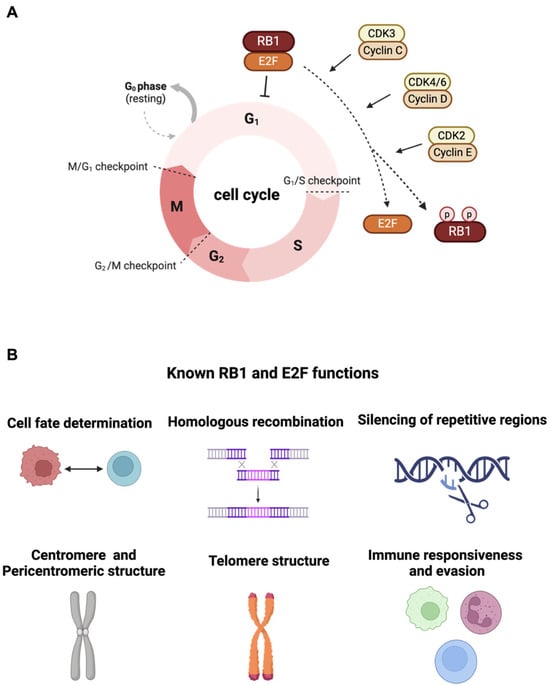
Figure 1
Open AccessReview
Glioma Stem Cells—Features for New Therapy Design
by
Nives Pećina-Šlaus and Reno Hrašćan
Cancers 2024, 16(8), 1557; https://0-doi-org.brum.beds.ac.uk/10.3390/cancers16081557 - 19 Apr 2024
Abstract
On a molecular level, glioma is very diverse and presents a whole spectrum of specific genetic and epigenetic alterations. The tumors are unfortunately resistant to available therapies and the survival rate is low. The explanation of significant intra- and inter-tumor heterogeneity and the
[...] Read more.
On a molecular level, glioma is very diverse and presents a whole spectrum of specific genetic and epigenetic alterations. The tumors are unfortunately resistant to available therapies and the survival rate is low. The explanation of significant intra- and inter-tumor heterogeneity and the infiltrative capability of gliomas, as well as its resistance to therapy, recurrence and aggressive behavior, lies in a small subset of tumor-initiating cells that behave like stem cells and are known as glioma cancer stem cells (GCSCs). They are responsible for tumor plasticity and are influenced by genetic drivers. Additionally, GCSCs also display greater migratory abilities. A great effort is under way in order to find ways to eliminate or neutralize GCSCs. Many different treatment strategies are currently being explored, including modulation of the tumor microenvironment, posttranscriptional regulation, epigenetic modulation and immunotherapy.
Full article
(This article belongs to the Special Issue Recent Advances in Rare Cancers: From Bench to Bedside and Back)
►▼
Show Figures
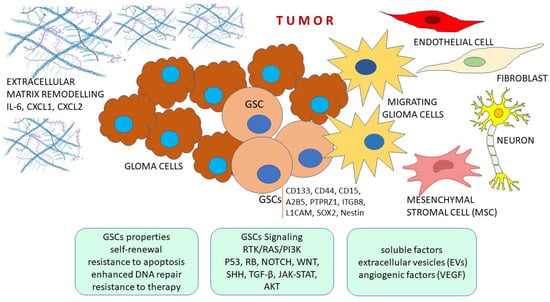
Figure 1
Open AccessArticle
Presence of CD44v9-Expressing Cancer Stem Cells in Circulating Tumor Cells and Effects of Carcinoembryonic Antigen Levels on the Prognosis of Colorectal Cancer
by
Katsuji Sawai, Takanori Goi, Youhei Kimura and Kenji Koneri
Cancers 2024, 16(8), 1556; https://0-doi-org.brum.beds.ac.uk/10.3390/cancers16081556 - 19 Apr 2024
Abstract
Circulating tumor cells (CTCs) are cancer cells released from the primary tumor into the bloodstream, and contain cancer stem cells that influence tumor survival, recurrence, and metastasis. Here, we investigated CD44v9 expression in CTCs and impact of preoperative carcinoembryonic antigen (CEA) levels on
[...] Read more.
Circulating tumor cells (CTCs) are cancer cells released from the primary tumor into the bloodstream, and contain cancer stem cells that influence tumor survival, recurrence, and metastasis. Here, we investigated CD44v9 expression in CTCs and impact of preoperative carcinoembryonic antigen (CEA) levels on colorectal cancer (CRC) prognosis. We analyzed the expression of CD44v9 mRNA in CTCs using reverse transcription-polymerase chain reaction and preoperative CEA levels in blood samples obtained from 300 patients with CRC. Subsequently, we evaluated the association of CD44v9 expression and CEA levels with clinicopathological factors. CD44v9 mRNA was expressed in 31.3% of the patients, and was significantly associated with liver metastasis. Patients with positive CD44v9 expression had a lower 5-year survival rate (62.3%) than those with negative CD44v9 expression (82.8%, p < 0.001). Cox regression analysis identified CD44v9 expression and high CEA levels (≥5 ng/mL) as poor prognostic factors, while negative CD44v9 expression and low CEA levels (<5 ng/mL) were associated with favorable prognosis (hazard ratio = 0.285, p = 0.006). These results suggest that a combination of CD44v9 mRNA expression in CTCs and serum CEA levels could serve as a valuable prognostic marker for CRC, potentially enhancing the accuracy of prognosis predictions.
Full article
(This article belongs to the Section Molecular Cancer Biology)
►▼
Show Figures

Figure 1
Open AccessEditorial
CDK Inhibitors and FDA: Approved and Orphan
by
Jonas Cicenas and Jokubas Simkus
Cancers 2024, 16(8), 1555; https://0-doi-org.brum.beds.ac.uk/10.3390/cancers16081555 - 19 Apr 2024
Abstract
The protein kinases are a large family of enzymes which catalyze protein phosphorylation at certain amino acids [...]
Full article
(This article belongs to the Topic Kinases in Cancer and Other Diseases, 2nd Edition)
►▼
Show Figures
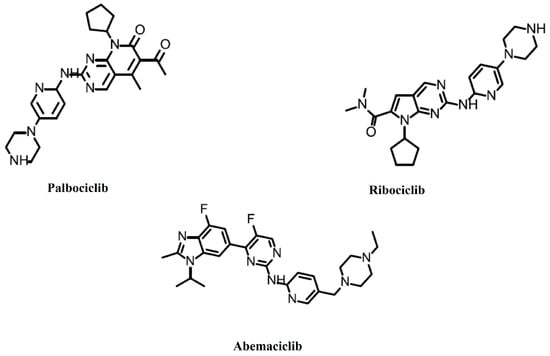
Figure 1
Open AccessReview
The Role of Curcumin in Cancer: A Focus on the PI3K/Akt Pathway
by
Vasiliki Zoi, Athanassios P. Kyritsis, Vasiliki Galani, Diamanto Lazari, Chrissa Sioka, Spyridon Voulgaris and Georgios A. Alexiou
Cancers 2024, 16(8), 1554; https://0-doi-org.brum.beds.ac.uk/10.3390/cancers16081554 - 18 Apr 2024
Abstract
Cancer is a life-threatening disease and one of the leading causes of death worldwide. Despite significant advancements in therapeutic options, most available anti-cancer agents have limited efficacy. In this context, natural compounds with diverse chemical structures have been investigated for their multimodal anti-cancer
[...] Read more.
Cancer is a life-threatening disease and one of the leading causes of death worldwide. Despite significant advancements in therapeutic options, most available anti-cancer agents have limited efficacy. In this context, natural compounds with diverse chemical structures have been investigated for their multimodal anti-cancer properties. Curcumin is a polyphenol isolated from the rhizomes of Curcuma longa and has been widely studied for its anti-inflammatory, anti-oxidant, and anti-cancer effects. Curcumin acts on the regulation of different aspects of cancer development, including initiation, metastasis, angiogenesis, and progression. The phosphatidylinositol-3-kinase (PI3K)/protein kinase B (AKT) pathway is a key target in cancer therapy, since it is implicated in initiation, proliferation, and cancer cell survival. Curcumin has been found to inhibit the PI3K/Akt pathway in tumor cells, primarily via the regulation of different key mediators, including growth factors, protein kinases, and cytokines. This review presents the therapeutic potential of curcumin in different malignancies, such as glioblastoma, prostate and breast cancer, and head and neck cancers, through the targeting of the PI3K/Akt signaling pathway.
Full article
(This article belongs to the Special Issue The Tumor Microenvironment and Its Role in Tumor Growth and Angiogenesis)
►▼
Show Figures
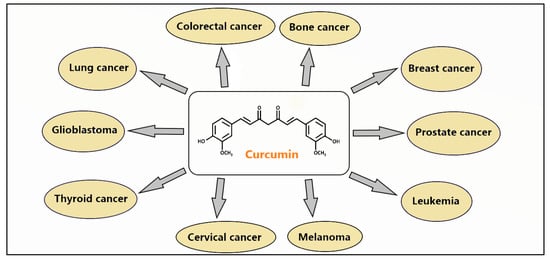
Figure 1
Open AccessReview
Early-Onset Gastrointestinal Malignancies: An Investigation into a Rising Concern
by
Aayush Vishwanath, Shreyas Krishna, Albert P. Manudhane, Phil A. Hart and Somashekar G. Krishna
Cancers 2024, 16(8), 1553; https://0-doi-org.brum.beds.ac.uk/10.3390/cancers16081553 - 18 Apr 2024
Abstract
There is growing recognition of early-onset gastrointestinal (GI) malignancies in young adults < 50 years of age. While much of the literature has emphasized colorectal cancer, these also include esophageal, gastric, liver, pancreatic, and biliary tract malignancies. Various factors, including lifestyle, hereditary, and
[...] Read more.
There is growing recognition of early-onset gastrointestinal (GI) malignancies in young adults < 50 years of age. While much of the literature has emphasized colorectal cancer, these also include esophageal, gastric, liver, pancreatic, and biliary tract malignancies. Various factors, including lifestyle, hereditary, and environmental elements, have been proposed to explain the rising incidence of GI malignancies in the younger population. This review aims to provide an overview of the recent literature, including global trends and information regarding genetic and environmental risk factors.
Full article
(This article belongs to the Special Issue Advances in Multi-Omics of Pediatric, Adolescence and Young Adult Cancers)
Open AccessSystematic Review
Systematic Review and Meta-Analysis of Laparoscopic versus Robotic-Assisted Surgery for Colon Cancer: Efficacy, Safety, and Outcomes—A Focus on Studies from 2020–2024
by
Roxana Loriana Negrut, Adrian Cote, Vasile Aurel Caus and Adrian Marius Maghiar
Cancers 2024, 16(8), 1552; https://0-doi-org.brum.beds.ac.uk/10.3390/cancers16081552 - 18 Apr 2024
Abstract
Background: Minimally invasive surgery in the treatment of colon cancer has significantly advanced over the years. This systematic review and meta-analysis aimed to compare the operative outcomes of robotic and laparoscopic surgery in the treatment of colon cancer, focusing on operative time, hospital
[...] Read more.
Background: Minimally invasive surgery in the treatment of colon cancer has significantly advanced over the years. This systematic review and meta-analysis aimed to compare the operative outcomes of robotic and laparoscopic surgery in the treatment of colon cancer, focusing on operative time, hospital stay, conversion rates, anastomotic leak rates, and total number lymph node harvested. Methods: Following PRISMA guidelines, we conducted a systematic search across four databases up to January 2024, registering our protocol with PROSPERO (CRD42024513326). We included studies comparing robotic and laparoscopic surgeries for colon cancer, assessing operative time, hospital length of stay, and other perioperative outcomes. Risk of bias was evaluated using the JBI Critical Appraisal Checklist. Statistical analysis utilized a mix of fixed and random-effects models based on heterogeneity. Results: A total of 21 studies met the inclusion criteria, encompassing 50,771 patients, with 21.75% undergoing robotic surgery and 78.25% laparoscopic surgery. Robotic surgery was associated with longer operative times (SMD = −1.27, p < 0.00001) but shorter hospital stays (MD = 0.42, p = 0.003) compared to laparoscopic surgery. Conversion rates were significantly higher in laparoscopic procedures (OR = 2.02, p < 0.00001). No significant differences were found in anastomotic leak rates. A higher number of lymph nodes was harvested by robotic approach (MD = −0.65, p = 0.04). Publication bias was addressed through funnel plot analysis and Egger’s test, indicating the presence of asymmetry (p = 0.006). Conclusions: The choice of surgical method should be individualized, considering factors such as surgeon expertise, medical facilities, and patient-specific considerations. Future research should aim to elucidate long-term outcomes to further guide the clinical decision-making.
Full article
(This article belongs to the Topic Recent Advances in Anticancer Strategies)
►▼
Show Figures
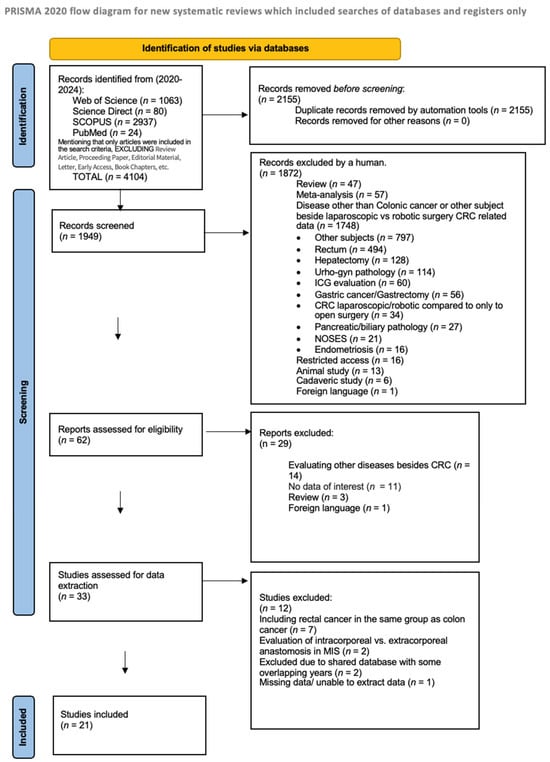
Figure 1
Open AccessReview
Molecular Landscape and Therapeutic Strategies against Colorectal Cancer
by
Aakash Patel and Pat Gulhati
Cancers 2024, 16(8), 1551; https://0-doi-org.brum.beds.ac.uk/10.3390/cancers16081551 - 18 Apr 2024
Abstract
Colorectal cancer (CRC) is the second leading cause of cancer deaths worldwide. Although the overall incidence of CRC is decreasing, the incidence of young-onset CRC, characterized by a diagnosis of CRC before age 50, is increasing. Outcomes for CRC patients are improving, partly
[...] Read more.
Colorectal cancer (CRC) is the second leading cause of cancer deaths worldwide. Although the overall incidence of CRC is decreasing, the incidence of young-onset CRC, characterized by a diagnosis of CRC before age 50, is increasing. Outcomes for CRC patients are improving, partly due to comprehensive molecular characterization of tumors and novel therapeutic strategies. Advances in genomic and transcriptomic analyses using blood- and tumor-tissue-based sequencing have facilitated identification of distinct tumor subtypes harboring unique biological characteristics and therapeutic vulnerabilities. These insights have led to the development and incorporation of targeted therapies and immunotherapy in CRC treatment. In this review, we discuss the molecular landscape and key oncogenes/tumor suppressors contributing to CRC tumorigenesis, metastasis, and therapeutic resistance. We also discuss personalized therapeutic strategies for subsets of CRC patients and provide an overview of evolving novel treatments being evaluated in clinical trials.
Full article
(This article belongs to the Special Issue Targeted Therapy in Gastrointestinal Cancer)
►▼
Show Figures
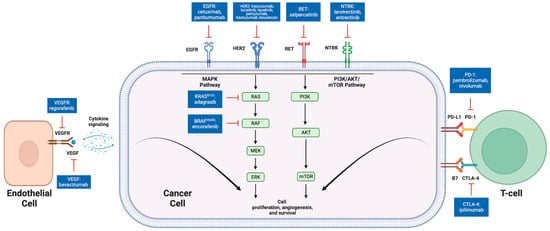
Figure 1
Open AccessReview
Precursor Lesions, Overdiagnosis, and Oral Cancer: A Critical Review
by
Nicola Cirillo
Cancers 2024, 16(8), 1550; https://0-doi-org.brum.beds.ac.uk/10.3390/cancers16081550 - 18 Apr 2024
Abstract
Despite the profession placing great emphasis on oral potentially malignant disorders (OPMDs) as a gateway for early recognition and consequently better outcomes for oral cancer, the death rates for lip and oral cavity cancer have remained stagnant for three decades. Evidence shows that
[...] Read more.
Despite the profession placing great emphasis on oral potentially malignant disorders (OPMDs) as a gateway for early recognition and consequently better outcomes for oral cancer, the death rates for lip and oral cavity cancer have remained stagnant for three decades. Evidence shows that only a small fraction of oral cancers are in fact preceded by OPMDs, and that most OPMDs have an annual transformation rate of less than 1%. As OPMDs encompass a very heterogeneous group of oral conditions, it could be argued that only patients with oral mucosal diseases bearing a substantial risk of malignant transformation warrant close surveillance and treatment, these include proliferative leukoplakia, erythroplakia, non-homogeneous leukoplakia, as well as diseases presenting with severe dysplasia at biopsy. In this narrative review, I discuss the intricate epidemiology of the malignancies that we colloquially refer to as oral cancer, explore the limitations of focusing on OPMDs to reduce the incidence and mortality of oral cavity cancer, and argue that a may-be cancer label represents overdiagnosis for most OPMDs.
Full article
(This article belongs to the Special Issue Oral Cancer: Prevention and Early Detection)
Open AccessSystematic Review
Prostate Tissue Microbiome in Patients with Prostate Cancer: A Systematic Review
by
Daniela F. Ward Grados, Onuralp Ergun, Carly D. Miller, Petr Gaburak, Nana A. Frimpong, Oluwatobi Shittu and Christopher A. Warlick
Cancers 2024, 16(8), 1549; https://0-doi-org.brum.beds.ac.uk/10.3390/cancers16081549 - 18 Apr 2024
Abstract
Some researchers have speculated that the prostatic microbiome is involved in the development of prostate cancer (PCa) but there is no consensus on certain microbiota in the prostatic tissue of PCa vs. healthy controls. This systematic review aims to investigate and compare the
[...] Read more.
Some researchers have speculated that the prostatic microbiome is involved in the development of prostate cancer (PCa) but there is no consensus on certain microbiota in the prostatic tissue of PCa vs. healthy controls. This systematic review aims to investigate and compare the microbiome of PCa and healthy tissue to determine the microbial association with the pathogenesis of PCa. We searched MEDLINE, Embase, and Scopus databases. Articles were screened by two independent and blinded reviewers. Literature that compared the prostatic tissue microbiome of patients with PCa with benign controls was included. We found that PCa may be associated with increased Propionibacterium acnes, the herpesviridae and papillomaviridae families, and Mycoplasma genitalium, but definitive conclusions cannot be drawn from the existing data. Challenges include the difficulty of obtaining uncontaminated tissue samples and securing tissue from healthy controls. As a result, methods are varied with many studies using cancerous and “healthy” tissue from the same prostate. The organisms chosen for each study were also highly variable, making it difficult to compare studies. These issues have led to lower confidence in our results. Overall, further work is warranted to better understand the implications of the prostatic microbiome in the pathogenesis of PCa.
Full article
(This article belongs to the Special Issue Advances in Therapeutic Strategies for Prostate Cancer)
►▼
Show Figures
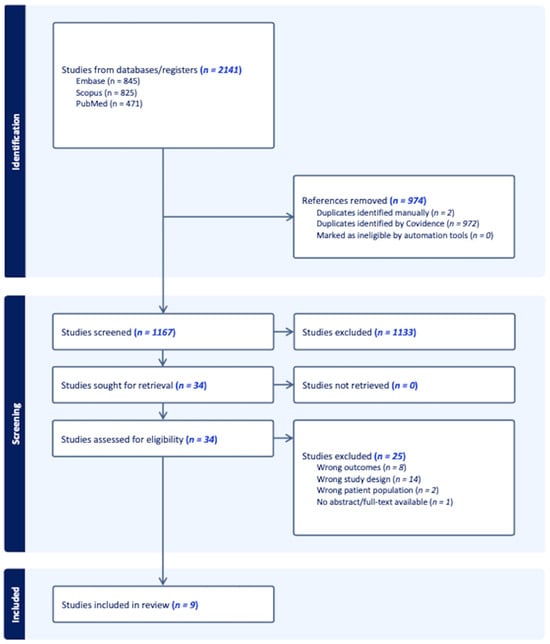
Figure 1
Open AccessSystematic Review
Oral Mucositis Management in Children under Cancer Treatment: A Systematic Review
by
Ricardo Braguês, Maria Francisca Marvão, Patrícia Correia and Raquel M. Silva
Cancers 2024, 16(8), 1548; https://0-doi-org.brum.beds.ac.uk/10.3390/cancers16081548 - 18 Apr 2024
Abstract
Children undergoing antineoplastic treatment often present severe side effects due to the dosage and duration of treatments, with oral mucositis emerging as one of the most prevalent and painful inflammatory conditions. There is a growing body of evidence on therapeutic interventions such as
[...] Read more.
Children undergoing antineoplastic treatment often present severe side effects due to the dosage and duration of treatments, with oral mucositis emerging as one of the most prevalent and painful inflammatory conditions. There is a growing body of evidence on therapeutic interventions such as cryotherapy, low-level laser therapy, and natural compounds for this condition. The aim of this systematic review was to identify and compare therapies for the management of cancer treatment-induced oral mucositis in pediatric patients. From 2655 articles obtained in initial searches, 39 articles were considered in this systematic review, after applying inclusion/exclusion criteria. Low-level laser therapy, palifermin, honey, and zinc demonstrated reductions in oral mucositis incidence, duration, severity, and pain reported by the patient. Although there are several therapies in place for the prevention and treatment of oral mucositis in children, evidence of their efficacy is still inconclusive to establish accurate clinical protocols.
Full article
(This article belongs to the Special Issue Supportive Care for Patients with Cancer)
►▼
Show Figures
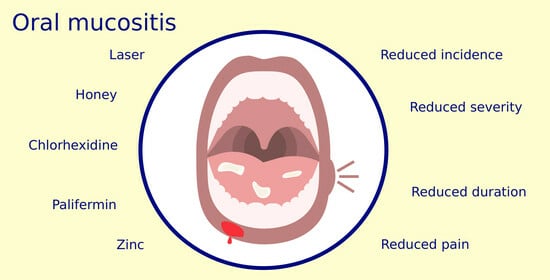
Graphical abstract
Open AccessArticle
Peritoneal Flap Following Lymph Node Dissection in Robotic Radical Prostatectomy: A Novel “Bunching” Technique
by
Ahmed Gamal, Marcio Covas Moschovas, Abdel Rahman Jaber, Shady Saikali, Marco Sandri, Ela Patel, Evan Patel, Travis Rogers and Vipul Patel
Cancers 2024, 16(8), 1547; https://0-doi-org.brum.beds.ac.uk/10.3390/cancers16081547 - 18 Apr 2024
Abstract
Background: Pelvic lymph node dissection (PLND) is recommended while performing robot-assisted radical prostatectomy (RARP) for patients with localized intermediate or high-risk prostate cancer. However, symptomatic lymphoceles can occur after surgery, adding significant morbidity to patients. Our objective is to describe a novel Peritoneal
[...] Read more.
Background: Pelvic lymph node dissection (PLND) is recommended while performing robot-assisted radical prostatectomy (RARP) for patients with localized intermediate or high-risk prostate cancer. However, symptomatic lymphoceles can occur after surgery, adding significant morbidity to patients. Our objective is to describe a novel Peritoneal Bladder Flap Bunching technique (PBFB) to reduce the risk of clinically significant lymphoceles in patients undergoing RARP and PLND. Methods: We evaluated 2267 patients who underwent RARP with PLND, dividing them into two groups: Group 1, comprising 567 patients who had the peritoneal flap (PBFB), and Group 2, comprising 1700 patients without the flap; propensity score matching carried out at a 1:3 ratio. Variables analyzed included estimated blood loss (EBL), operative time, postoperative complications, lymphocele formation, and the development of symptomatic lymphocele. Results: The two groups exhibited similar preoperative characteristics after matching. There was no statistically significant difference in the occurrence of lymphoceles between the flap group and the non-flap group, with rates of 24% and 20.9%, respectively (p = 0.14). However, none of the patients in the flap group (0%) developed symptomatic lymphoceles, whereas 2.2% of patients in the non-flap group experienced symptomatic lymphoceles (p = 0.01). Conclusion: We have demonstrated a modified technique for a peritoneal flap (PBFB) with the initial elimination of postoperative symptomatic lymphoceles and promising short-term outcomes.
Full article
(This article belongs to the Special Issue Advances in the Management of Pelvic Tumors)
►▼
Show Figures
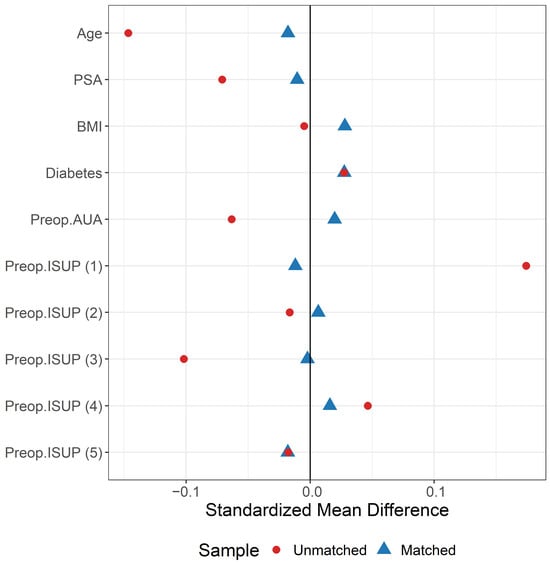
Figure 1

Journal Menu
► ▼ Journal Menu-
- Cancers Home
- Aims & Scope
- Editorial Board
- Reviewer Board
- Topical Advisory Panel
- Instructions for Authors
- Special Issues
- Topics
- Sections & Collections
- Article Processing Charge
- Indexing & Archiving
- Editor’s Choice Articles
- Most Cited & Viewed
- Journal Statistics
- Journal History
- Journal Awards
- Society Collaborations
- Conferences
- Editorial Office
Journal Browser
► ▼ Journal BrowserHighly Accessed Articles
Latest Books
E-Mail Alert
News
Topics
Topic in
Biomedicines, BioMedInformatics, Cancers, JCM, Cells, Current Oncology
Cancer Immunity and Immunotherapy: Early Detection, Diagnosis, Systemic Treatments, Novel Biomarkers, and Resistance Mechanisms
Topic Editors: Tao Jiang, Yongchang ZhangDeadline: 20 April 2024
Topic in
Bioengineering, Biomolecules, Cancers, Diseases, Nanomaterials, Pharmaceutics
Dynamic Nano-Biomaterials in Tissue Regeneration and Cancer Therapies
Topic Editors: Ramar Thangam, Heemin Kang, Bibin G. Anand, Ramachandran Vijayan, Venugopal KrishnanDeadline: 15 May 2024
Topic in
Biomedicines, Cancers, JFB, Nanomaterials, Polymers
Advanced Functional Materials for Regenerative Medicine
Topic Editors: Antonino Morabito, Luca ValentiniDeadline: 6 June 2024
Topic in
Biology, Cancers, Current Oncology, Diseases, JCM, Pathogens
Pathogenetic, Diagnostic and Therapeutic Perspectives in Head and Neck Cancer
Topic Editors: Shun-Fa Yang, Ming-Hsien ChienDeadline: 20 June 2024

Conferences
Special Issues
Special Issue in
Cancers
The Role of Tunneling Nanotubes in Intercellular Communication and Pathophysiology of Cancer
Guest Editor: Emil LouDeadline: 25 April 2024
Special Issue in
Cancers
Innovations in Diagnosis and Treatment of Colon and Rectal Cancer: Preoperative Optimisation, Multidisciplinary Management, and Surgical Technology Advancement
Guest Editor: Gianluca PellinoDeadline: 30 April 2024
Special Issue in
Cancers
Molecular and Cellular Heterogeneity in an Evolving Tumor Landscape: When Diversity Gives Rise to Aggressive and Drug Resistant Cells
Guest Editor: Michelle R. DawsonDeadline: 20 May 2024
Special Issue in
Cancers
Innovations in Soft Tissue Sarcoma Diagnosis and Treatment
Guest Editors: Sant P. Chawla, Erlinda M. Gordon, Frederick L. HallDeadline: 30 May 2024
Topical Collections
Topical Collection in
Cancers
Drug Resistance and Novel Therapies in Cancers
Collection Editor: Zhixiang Wang



